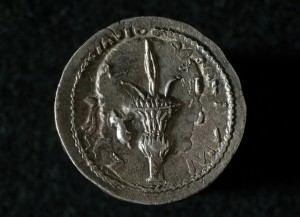 We have evidentiary documentation of the celebration of the holidays of Rosh Hashanah, Yom Kippur, Sukkot, and the related holidays of Hosha ‘na Rabba and Shemini Atzeret, beginning with the Apostle Paul, the great Jewish Historian Josephus (37-100 CE), author of Antiquities of the Jews, and the Roman Historian, Plutarch (46-120 CE), the author of Parallel Lives. A remarkable archaeological find in 1953 proves that Simon Bar Kokhba who led the rebellion (132-134 CE) against Emperor Hadrian, set time aside to prepare for Sukkot. It should be noted that Hadrian built a temple to Jupiter with a statue of himself on a horse on the site of the Jewish Temple. He also changed the name of Jerusalem to Aelia Capitolina and the name of Judea to Palaestina. In response, Bar Kokhba overstruck coins with the inscription “For the Freedom of Jerusalem” and the symbols of Sukkot: the lulav and etrog.
We have evidentiary documentation of the celebration of the holidays of Rosh Hashanah, Yom Kippur, Sukkot, and the related holidays of Hosha ‘na Rabba and Shemini Atzeret, beginning with the Apostle Paul, the great Jewish Historian Josephus (37-100 CE), author of Antiquities of the Jews, and the Roman Historian, Plutarch (46-120 CE), the author of Parallel Lives. A remarkable archaeological find in 1953 proves that Simon Bar Kokhba who led the rebellion (132-134 CE) against Emperor Hadrian, set time aside to prepare for Sukkot. It should be noted that Hadrian built a temple to Jupiter with a statue of himself on a horse on the site of the Jewish Temple. He also changed the name of Jerusalem to Aelia Capitolina and the name of Judea to Palaestina. In response, Bar Kokhba overstruck coins with the inscription “For the Freedom of Jerusalem” and the symbols of Sukkot: the lulav and etrog.
- Hebrew Biblical Texts
- The Apostle Paul, 63 CE: Yom Kippur
- Josephus, 80 CE: Yom Kippur and Sukkot
- Plutarch, 100 CE: Yom Kippur, Sukkot, and Shemini Atzeret
- Simon Bar Kokhba, 132-135 CE: Sukkot
- Mishnah, 300 CE: Rosh Hashanah and Yom Kippur
- Byzantine Empress Eudocia, 438 CE: Sukkot
- Solomon ben Judah: Sukkot and Hosha ‘na rabba
- Isaac ben Joseph ibn Chelo, 1334 CE: Rosh Hashanah and Yom Kippur